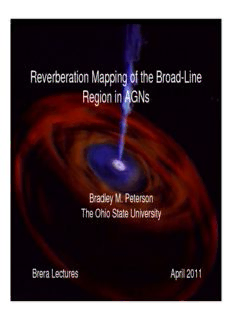
REVERBERATION MAPPING OF THE BROAD-LINE REGION IN AGNs PDF
Preview REVERBERATION MAPPING OF THE BROAD-LINE REGION IN AGNs
Reverberation Mapping of the Broad-Line Region in AGNs Bradley M. Peterson The Ohio State University Brera Lectures April 2011 1 Topics to be Covered • Lecture 1: AGN properties and taxonomy, fundamental physics of AGNs, AGN structure, AGN luminosity function and its evolution • Lecture 2: The broad-line region, emission- line variability, reverberation mapping principles, practice, and results, AGN outflows and disk-wind models, the radius– luminosity relationship • Lecture 3: Role of black holes, direct/indirect measurement of AGN black hole masses, relationships between BH mass and AGN/host properties, limiting uncertainties and systematics 2 The Broad-Line Region (BLR) • Why focus on the BLR? – It is the gas closest to the central source, and it would be surprising if it is not involved in fueling the central black hole. – Central black hole apparently dominates kinematics, enabling measurement of black hole mass (Lecture 3). • Difficulty: its angular size is only a few tens of microarcseconds, even in nearby AGNs. 3 Some Simple Inferences • Temperature of gas is ~104 K – Thermal width ~10 km s–1 • Density is high, by nebular standards (n e 109 cm–3) – Efficient emitter, can be low mass • Line widths FWHM 1000 – 25,000 km/sec Gas moves supersonically 4 What is the • First notions based on BLR? Galactic nebulae, especially the Crab – system of “clouds” or “filaments.” • Merits: – Ballistic or radiation- pressure driven outflow logarithmic profiles – Virial models implied very large masses • Early photoionization models overpredicted size of BLR (to be shown) Crab Nebula with VLT 5 What is the • Number of clouds N of c radius R : BLR? c – Covering factor N R 2 c c Flaw in the argument: emissivity per – Line luminosity N R 3 c c cloud is not proportional to cloud – Combine these to find volume, but N R 2R c c Stromgren Number and size not independently large number (N > 108) c constrained. of small (R 1013 cm) c clouds. – Combine size and density (n 1010 cm-3), H to get column density (N 1023 cm-2), H compatible with X-ray absorption. – Minimum mass of line- Crab Nebula with VLT emitting material ~1M . Large Number of Clouds? • If clouds emit at thermal width (10 km/sec), then there must be a very large number of them to account for lack of small-scale structure in line profiles. NGC 4151 7 Arav et al. (1998) Emission-Line Variability • First reported by Andrillat & Souffrin based on photographic spectra of NGC 3516 • Subsequent reports were scattered, and seemed to be widely regarded as “curiosities”. Tohline and Osterbrock (1976) Andrillat & Souffrin 1968 Phillips (1978) Emission-Line Variability • Only very large changes could be detected photographically or with intensified television-type scanners (e.g., Image Dissector Scanners). • Changes that were observed were often dramatic and reported as Seyferts changing “type” as broad components appeared or disappeared. Tohline & Osterbrock 1976 Emission-Line Profile Variability • Variability of broad emission-line profiles was detected in the early Foltz et al. 1981 1980s. • This was originally thought to point to an ordered velocity field and Kollatschny et al. propagation of excitation 1981 inhomogeneties. • Led to development of reverberation mapping (seminal paper by Blandford & McKee Schulz & Rafanelli 1981 1982). 10
Description: